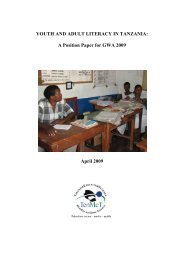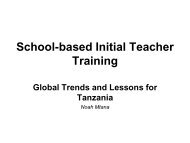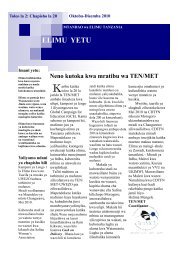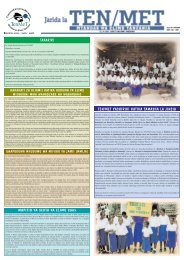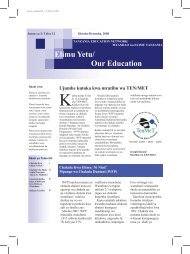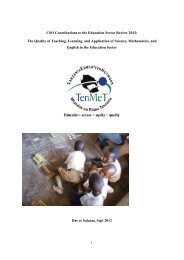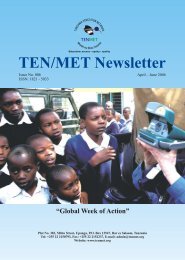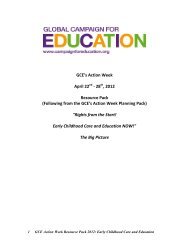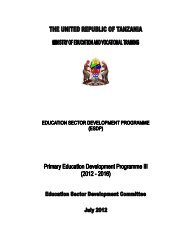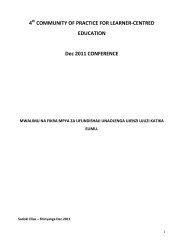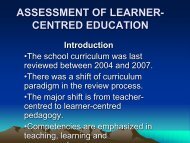How Language Affects Learning and Assessment Mwajuma Vuzo ...
How Language Affects Learning and Assessment Mwajuma Vuzo ...
How Language Affects Learning and Assessment Mwajuma Vuzo ...
Create successful ePaper yourself
Turn your PDF publications into a flip-book with our unique Google optimized e-Paper software.
<strong>How</strong> <strong>Language</strong> <strong>Affects</strong> <strong>Learning</strong> <strong>and</strong> <strong>Assessment</strong><strong>Mwajuma</strong> <strong>Vuzo</strong>Abstract<strong>Language</strong> is crucial in the teaching <strong>and</strong> learning process <strong>and</strong> more so in assessment.<strong>Assessment</strong> as a component of evaluation illustrates the extent to which content taught hasbeen acquired. If students fail to underst<strong>and</strong> <strong>and</strong> use well the language used for assessmentthey will clearly fail to show knowledge gained. Likewise, if they can use <strong>and</strong> underst<strong>and</strong>well the language used they will clearly show knowledge gained. Therefore, a familiarlanguage should be used for learning, teaching <strong>and</strong> assessment.This paper highlights the importance of language in learning <strong>and</strong> assessment as; studentscan fail to answer well questions well simply because they fail to underst<strong>and</strong> the question, notbecause they do not know the answer. <strong>Language</strong> can affect a learners‟ ability to interpretinstructions <strong>and</strong> questions. It can also lead to failure to express their ideas appropriately.Students also may not be familiar with the English vocabularies used. The paper will drawfrom findings of previous studies that show how language affects students‟ performance. Thepaper recommends that a familiar language should be used for assessment purposes tomaximize students‟ performance.
2IntroductionThe importance of language in learning cannot be underestimated. Jones <strong>and</strong> Rubagumya(1998) identified three functions of language in the classroom: language for buildingrelationships with each other; language for teaching <strong>and</strong> learning, <strong>and</strong> language fordeveloping communicative abilities. They recognize the second <strong>and</strong> third functions as themost crucial for learning.<strong>Language</strong> plays a very big role in education since the teaching <strong>and</strong> learning processcannot take place without it. It is through language that learners read, comprehend, <strong>and</strong>effectively interact during teaching-learning process. Interaction is effected through asking<strong>and</strong> responding to questions or when discussing issues pertaining to their subjects of interest(<strong>Vuzo</strong>, 2002). If learners <strong>and</strong> even teachers are disabled in the language that is used as amedium of instruction, then the learning process cannot take place effectively (Malekela,2004). In this case, language can simultaneously play conflicting roles in the educationalsphere. It can be a factor in either providing or withholding access to education (Roy-Campbell, 2001).According to Tanzania‟s Education <strong>and</strong> Training policy of 1995, primary education <strong>and</strong>Teachers‟ Training Colleges for primary school teachers in Tanzania use Kiswahili as thelanguage of instruction, while Secondary as well as Tertiary education learning should bethrough English <strong>and</strong> Kiswahili remains only as a subject (URT, 1995). Hence, the languagesin question for learning <strong>and</strong> assessment in Tanzania are Kiswahili <strong>and</strong> English.UNESCO (2003) emphasizes that it is an obvious yet not generally recognized truth thatlearning in a language which is not one‟s own provides a double set of challenges. Not only isthere the challenge of learning a new language but also that of learning new knowledgecontained in that language. Due to the MOI policy currently in practice in Tanzaniansecondary schools, the problems facing students <strong>and</strong> teachers alike are manifold. In theprimary schools in Tanzania, Kiswahili is used as the MOI but the performance is not good,this illustrates the point that language is important but not a sole contributor to qualityeducation. Other factors such as lack of teaching <strong>and</strong> learning resources, time on task inteaching <strong>and</strong> learning, teacher commitment, high teacher student ratios should be taken intoconsideration <strong>and</strong> can explain why the performance in primary schools is poor despite using afamiliar language for instruction.Likewise Vygotsky (1962) asserts that language plays an essential role in cognitivedevelopment, at least from the time the child has attained a certain amount of language
3competence. <strong>Language</strong>, first developed as a means of social communication, is laterinternalized <strong>and</strong> becomes a crucial tool in the shaping of cognitive processes relevant for theelaboration of abstract symbolic systems which will enable a child to organize thought.Building on this conception Wells (1999: 143) states that „<strong>Language</strong> is the essential conditionfor knowing, the process by which experience becomes knowledge‟.Vygotsky (1987) developed the concept of the zone of proximal development inlearning, which states that children can accomplish more difficult tasks when they have theassistance of people more advanced <strong>and</strong> competent than themselves. This is facilitated bydialogic interactions in which the more capable participants guide the learners inaccomplishing specific tasks (Lantolf 1994). This means that teaching methods which involvesocial interaction as much as possible as interaction between those who know more, eitherteacher or other students, <strong>and</strong> those who know less, leads to learning <strong>and</strong> development.Cameron (2001) brings out some of the implications of Vygotsky‟s theory to learning.She argues that in the zone of proximal development the teacher can do various things tosupport learning as a mediator. For instance, the teacher can decide what the learner can do inlesson planning <strong>and</strong> in how the teachers talk to pupils minute by minute in class.Furthermore, the idea of learning as internalization suggests that the language can be usedmeaningfully by teacher <strong>and</strong> pupils, so that later knowledge is transformed <strong>and</strong> internalized tobecome part of the individual child‟s skills of knowledge. Within the zone of proximaldevelopment, the broader <strong>and</strong> richer the experience that is provided for children, the morethey are likely to learn. Hence, if we want children to develop certain skills, we need toensure they have experiences in lessons that will build those skills.Freire (1993) criticizes the banking model of education in which teachers depositknowledge into students, who are seen as passive receptacles. The banking model ofeducation is characterized by narration <strong>and</strong> so diminishes the students‟ creativity. This leadsstudents to memorize knowledge mechanically <strong>and</strong> turns students to containers. Freire (1993)insists that when the teacher is the expert whose task it is to transmit knowledge, to filllearners with new information <strong>and</strong> skills, <strong>and</strong> when learners‟ own knowledge is excluded,they are silenced <strong>and</strong> powerless. This is because the teacher knows everything <strong>and</strong> thestudents know nothing. The teacher thinks <strong>and</strong> the students are thought about. Moreover theteacher is the subject of the learning process, while the students are mere objects (Freire1993). Instead, participatory education should be the aim of classroom interaction wherelearners‟ experience <strong>and</strong> knowledge are at the centre of the pedagogical processes.
4Freire (1993) therefore, emphasizes dialogic <strong>and</strong> problem posing learning. Dialogueavoids the contradictions between the teacher <strong>and</strong> the learners. As a result a new relation ofcomplementarity develops where the teacher <strong>and</strong> students exchange roles making bothteachers <strong>and</strong> learners active. He maintains that such an approach enables the students todevelop their own power to perceive issues critically <strong>and</strong> makes them increasingly challenged<strong>and</strong> thereby obliged to respond to the challenges. It is crucial to encourage such strategies asin this way we will emphasize underst<strong>and</strong>ing, rather than rote drills, which is fundamental(Brunner 2002). In the same spirit Eble (1988) asserts that student-centred discussions aremore effective than instructor-lead discussions for goals of retention, application, problemsolving, attitude change, <strong>and</strong> motivation for future learning.In order to manage classroom discourse effectively the teachers‟ <strong>and</strong> students‟competence in the MOI is a requirement for quality classroom discourse. Accordingly Lemke(1989) declares that there are two tensions in language use in classroom discourse. The first isthe tension between the use of the language to teach content; the second that of managingsocial interaction in the classroom. Both are especially consequential to the shaping ofindividual learner‟s development <strong>and</strong> in facilitating learning. <strong>How</strong>ever, in the Tanzaniancontext these tensions are persistent <strong>and</strong> have not been alleviated. This situation is partly as aresult of what Phillipson (1992) alludes to that it is easier to listen to a language that one isused to. Listening to a foreign language dem<strong>and</strong>s more intensive attention (partly becausethere is less redundancy for a foreigner). She suggests that a learner, receivingincomprehensible input <strong>and</strong> trying to underst<strong>and</strong> it, has to have more frequent <strong>and</strong> maybelonger pauses. This also reduces the amount of input that the child gets.For this reason, only few students use language usefully for interaction between theirpeers <strong>and</strong> between them <strong>and</strong> their teachers. This has detrimental consequences <strong>and</strong> Brunner(2002) warns that rather than only schooling the better student, it is important to help eachstudent achieve his optimum intellectual development, as the most general objective ofeducation is to cultivate excellence.Synopsis of Previous Studies on Effects of <strong>Language</strong> on <strong>Learning</strong><strong>Vuzo</strong> (2007) did a study to compare the teaching of geography using different media ofinstruction. The objective of the study was to find out if there were differences shown inForm I geography classes taught in different MOI. The MOI of instruction used were English,the current official MOI, Kiswahili which is the proposed MOI but is not yet officiallyimplemented, <strong>and</strong> code switching, the unofficial MOI currently in practise. The study wasconducted in two government secondary schools. The main data gathering techniques used in
5this study were: a quasi experiment in which two tests were administered, classroomobservations, document analysis, <strong>and</strong> interviews with headmasters, teachers, <strong>and</strong> students ofthe respective schools. This paper will focus on findings from the quasi experiment <strong>and</strong> testsgiven.There was a total of 364 students participating in the quasi-experimental study. Thedesign that was used in this study is one that Shadish, Cook, <strong>and</strong> Campbell (2002) refer to asa post test-only design with non equivalent groups. In this design there is a control group forthe one-group post test only design. In this study there were three distinct groups; rather thanone-group post tests only design, there were two groups with post test only design. The testwas referred to as a post test as it was taken after the experimental treatments. The design thatwas used can be diagrammed as follows where the numbers 1-3 pertain to the respectivegroups as they are referred to in this study while X is the respective treatment <strong>and</strong> O refers tothe post test:1. -- O (Control group- code switching as MOI)2. X O 1 (Kiswahili only as MOI)3. X O 2 (English only as MOI)As already mentioned, the groups used for the comparisons were pre existing or intactgroups of school streams. Two groups were experimental, receiving the treatment ofKiswahili <strong>and</strong> English as the sole MOI, while one group where CS was the MOI was acontrol group, as it had no artificially induced changes. The use of control groups facilitatedbetter comparison between the groups as control groups provided a baseline against whichthe effects of the experimental treatment were evaluated. Shadish, Cook, <strong>and</strong> Campbell(2002) contend that the use of a control group in an experiment is a classic method forsupporting counterfactual inference. Groups using CS as the MOI were the control groups asit is in essence the normal practice to use CS as the MOI, although it is unofficial. This is acoping strategy that teachers <strong>and</strong> students currently use although the official policy states thatEnglish is the MOI. The control group where CS was the MOI was the reference point fromwhich the results of the experimental groups could be compared. The two experimentalgroups were artificially induced; the use of Kiswahili <strong>and</strong> English respectively as sole MOI.Kiswahili is not the MOI in Tanzanian secondary schools while English, though it isofficially stipulated as the MOI, is not used as the sole MOI. Students used in this study were
8English grammar. This tended to drag the lessons <strong>and</strong> attributed to failure to complete thelesson plan or teachers just completing it hastily.The nature of questions asked by the majority of students in Kiswahili MOI lessons weregenerally long <strong>and</strong> appropriately formed <strong>and</strong> usually quite reasoned. This challengedteachers to give detailed explanations. In English MOI most questions asked requiredsimple definitions or repetitions.Students‟ confidence was much higher in Kiswahili MOI. Students seemed confident <strong>and</strong>courageous as they spoke aloud, looking up to the teacher as they gave answers oftenwithout delay. They courageously presented challenging questions to the teachers. InEnglish MOI lessons it appeared that students generally lacked confidence as they spokein low tones. They often gave chorus answers or repeated previous answers from fellowstudents. Students usually did not present any challenge to the teacher.Teachers teaching in English MOI generally relied heavily on the lesson notes. This wasunlike in Kiswahili MOI classes where the teacher appeared to master the content suchthat explanations flowed out more easily <strong>and</strong> naturally in Kiswahili MOI.When code switching was used as the MOI, student-student <strong>and</strong> teacher-studentinteraction was also high. This was especially so when Kiswahili dominated the lesson. Incode switching MOI there was no formula in the use of the different languages. In somecases more Kiswahili <strong>and</strong> less English was used <strong>and</strong> vice versa applied though rarely. Inthese classes the more the Kiswahili used the more the student participation.The main reasons noted for code switching were the socializing role of the teacher, theneed to translate, elaborate by repetition <strong>and</strong> both teachers‟ <strong>and</strong> students‟ Englishlanguage incompetence <strong>and</strong> insecurity.Results from students‟ test performance indicated that students taught in Kiswahili MOIperformed considerably better than the others. Students‟ in CS as MOI were in the mediocreposition. Students taught in English performed most poorly <strong>and</strong> illustrated large disparitiescompared to those in Kiswahili MOI. These findings underscore the criticisms for the use of aforeign language as MOI. Teachers gave their views to illustrate why this was so:In Kiswahili students have performed better especially in questions requiring them togive lengthy details. Answers in English are very brief <strong>and</strong> students seem not to haveunderstood the questions. (A)
9In Kiswahili MOI classes the variation between students is minimal compared to inEnglish where there is big variation between high <strong>and</strong> low performing students. (B)In some sections those who were taught using a mix of English <strong>and</strong> Kiswahili MOIperformed better in questions requiring explanations than those students who were taught inEnglish MOI. (D)There are some students in my class where CS was the MOI who have done better thanthey normally do; allowing them to use Kiswahili in the tests has made it easy for them asthey understood questions <strong>and</strong> instructions. (C)Students’ Overall Test PerformanceTest 1 Overall DescriptionThe different MOI used in this study were characterized into three groups whereby group1 refers to CS, group 2 refers to Kiswahili, <strong>and</strong> group 3 refers to English MOI. The results fortest 1 showed that there were variations in the different groups of the MOI. Such that theoverall mean scores for the respective groups in both schools was group 1, M=56.18, group 2,M=63.64 while group 3, M=49.85. Generally group 2 has a much higher mean compared tothe other two groups <strong>and</strong> group 1 has a higher mean than group 3.All the three groups in this study had a reasonably high range: The range for group 1(67), for group 2 (66) <strong>and</strong> group 3 (77). It is evident here that the range was lowest for group2 compared to the other two groups <strong>and</strong> was highest for group 3. There is a very slightdifference in the range for group 1 <strong>and</strong> group 2. The st<strong>and</strong>ard deviation for Group 3 wass=16.87 which was the highest compared to that of the other two groups, with a st<strong>and</strong>arddeviation of s=15.00 <strong>and</strong> s=12.43 for groups 1 <strong>and</strong> 2 respectively. Thus group 2 has the leastst<strong>and</strong>ard deviation in comparison to that of the other two groups. There is a slight variation inthe st<strong>and</strong>ard deviation of group 1 <strong>and</strong> 3. More details on test 1 performance are presented intable 6.15 below.Table 6.15: Descriptive Overview of Students’ Scores in Test 1GroupCode Switching Kiswahili EnglishMean 56.18 63.64 49.85Variance 225.276 154.54 284.776Std. Deviation 15.009 12.431 16.875Minimum 13 20 4
10Maximum 80 86 81Range 67 66 776.5.2. Test 2 Overall DescriptionIn test 2 the overall mean scores for the respective groups were, for group 1, M=48.26,for group 2, <strong>and</strong> for group 3 M=54.49 <strong>and</strong> M=42.46, respectively. Generally again group 2has a higher mean compared to the other two groups. There was a mean difference of at least6 marks between all groups. The mean difference between group 3 <strong>and</strong> 2 is 12 marks which isquite a big difference. The overall mean results suggested that students in group 2 haveperformed better than students in the other two groups while students in group 3 haveperformed the poorest. This reiterated the same trend observed in performance in test 1. Therange of score in all the three groups was high. The range of scores in the groups was; group1 (70) <strong>and</strong> group 3 (77) while the range of scores in group 2 (67) which was comparativelyless than the other two groups although not so different to the range in group 1. Again therange for group 3 is the highest. The variation of scores around the mean, in other words thest<strong>and</strong>ard deviation (s) is highest in group 3 s=16.64 <strong>and</strong> least in group 2, s=12.50 while thest<strong>and</strong>ard deviation for group 1, s=15.72 is in between. More details are presented in table6.16 below.Table 6.16: Descriptive Overview of Students’ Scores in Test 2GroupCode Switching Kiswahili EnglishMean 48.26 54.49 42.46Variance 247.126 156.327 277.019Std. Deviation 15.720 12.503 16.644Minimum 9 18 5Maximum 79 85 82Range 70 67 77
Mean TEST111Overall Differences Exerted in the Different MOI by SchoolThere were variations in the test scores between the different experimental groups withinthe same school. In test 1 for school X for instance group 2 (Kiswahili) has the highest meanscore M=63.50 followed by group 1 (CS) with a mean of M=56.48 <strong>and</strong> lastly group 3(English) with a mean score of M=53.17. The st<strong>and</strong>ard deviation between the groups withinschool X also varied where the st<strong>and</strong>ard deviation is least in group 2 s=12.05 compared tos=14.56 <strong>and</strong> s=15.17 in groups 1 <strong>and</strong> 3 respectively. Hence the st<strong>and</strong>ard deviation is highestin group 3 (English) compared to the other two groups <strong>and</strong> is least in group 2. Observinggraph 1 (see below), in school X it is noted that there is an enormous variation between group2 <strong>and</strong> 3 while the difference between group 1 <strong>and</strong> 3 does not appear to be as big.Graph I: Mean Scores for Test 1 by SchoolMean Scores for Test 1 by School706050GROUP40CODE SWITCHINGKISWAHILI30XYENGLISHSCHOOLThe same applied in test 1 for school Y. There were variations within the differentgroups. Group 2 has the highest mean score of M=63.89 followed by group 1 with a meanscore of M=55.76 <strong>and</strong> lastly group 3 with a mean of M=46.30. Hence group 3 has the lowestmean score compared to the other two groups. Meanwhile the st<strong>and</strong>ard deviation for group 2,s=13.18 is the smallest compared to that of group 1, s=15.83 <strong>and</strong> that of group 3, s=18.01.Group 3 has the highest st<strong>and</strong>ard deviation while group 2 has the least variation of scoresaround the mean. It is also implied from the mean scores <strong>and</strong> from graph I (See above) thatthere were immense differences in mean scores particularly between group 2 <strong>and</strong> 3 in school
Mean TEST212Y. Therefore both schools X <strong>and</strong> Y in test 1 have highest mean scores attained in group 2(Kiswahili). This is followed by the mean scores in group 1. The mean scores of group 3(English) was lowest in comparison to the other two groups.Graph Mean II: Mean Scores for Test 2 by 2 School by School706050GROUP40CODE SWITCHINGKISWAHILI30XYENGLISHSCHOOLAs it is observed from graph II on mean scores in test 2 there is a variation betweenmean scores for all groups within the schools. The differences between the groups are quitepronounced. It is observed in the graph particularly the difference between group 2 <strong>and</strong> 3 inboth schools X <strong>and</strong> Y. In test 2 in school X, the mean score for group 2 is highest M=55.65compared to that of the other two groups where the mean is M=49.17 <strong>and</strong> M=44.98 in groups1 <strong>and</strong> 3 respectively. Hence the same trend as in test 1 is maintained. Group 3 has the lowestmean score. The st<strong>and</strong>ard deviation is least in group 2, s=11.08 compared to that of the othertwo groups where it is s=15.81 <strong>and</strong> s=16.58 in groups 1 <strong>and</strong> 3 correspondingly. There is aslight difference in the st<strong>and</strong>ard deviation of group 1 <strong>and</strong> 3 but an immense difference in thest<strong>and</strong>ard deviation between group 2 <strong>and</strong> the other two groups. Likewise in school Y, themean score for group 2 (Kiswahili); M=52.82 is highest followed by mean scores of group 1(CS); M= 47.24 <strong>and</strong> lastly that of group 3 (English); M= 40.31. As such group 3 has thelowest overall mean scores. The st<strong>and</strong>ard deviation is highest in group 3, s=16.54 followedby that of group 1, s=15.743 <strong>and</strong> the least st<strong>and</strong>ard deviation is that of group 2.
Mean TEST270Mean Scores for Test 2 by Teacher136050TEACHERB40AD30CODE SWITCHINGKISWAHILIENGLISHCGROUPThe independent variable in this case was the MOI with three levels or conditions; CS,Kiswahili, <strong>and</strong> English MOI, whereas the dependent continuous variables were the two testsadministered in the study.DiscussionThe findings of this study suggest that the use of English MOI in Tanzania is ineffective<strong>and</strong> encompasses several difficulties. It affirmed previous findings from Roy-Campbell <strong>and</strong>Qorro (1997), Brock-Utne (2000, 2005), <strong>Vuzo</strong> (2002); Qorro (2003) Galabawa <strong>and</strong> Lwaitama(2004), Roy-Campbell (2001), <strong>and</strong> Rubagumya (2000) among others. Due to lack ofcompetence in English, students‟ capacity to maximize the use of learning facilities arelimited. For instance most of them cannot read <strong>and</strong> exp<strong>and</strong> their knowledge from text bookson their own. Therefore, they rely heavily on teachers, some of whom are incompetent inEnglish MOI <strong>and</strong> encounter similar limitations. The depository strategy not recommended forthe teaching especially when a competence based curriculum is predominant using English asthe MOI. In these classes memorization <strong>and</strong> chorus teaching characteristic of safe talk areused. Herein students‟ creativity is thwarted. This presumably explains why we are currentlyfacing this predicament of recurrent failure.These findings establish the point by ADEA (2005) that language policies in favour offoreign languages as the MOI prevent millions of Africans from communicating betweenthemselves, from accessing knowledge <strong>and</strong> adapting such knowledge to their needs toimprove their living conditions. Such findings cement what Phillipson (1992: 286) states that,„for children whose mother tongue is not English, “…not the language of intense personal
14feelings <strong>and</strong> the community, not the language most appropriate for learning to solve problemsin cognitively dem<strong>and</strong>ing decontextualized situations, …English does not do what is claimedfor it, often the opposite”.Students‟ performance in Kiswahili MOI surpassed that of performance in English or CSMOI. Students‟ performance in CS as MOI was in the mediocre position while that ofEnglish MOI was disappointingly low. Noted from the overall findings is that there wereclear indications that learning in Kiswahili MOI improved teaching <strong>and</strong> learning conditions<strong>and</strong> equalized opportunities for all learners. Transfer of knowledge gained in class to thecommunity <strong>and</strong> vice versa can be enhanced due to the use of the same language in class <strong>and</strong>the home. These findings underline what UNESCO (2003) says that instruction in the mothertongue or familiar language contributes far more to the cultural, affective, cognitive <strong>and</strong>socio-psychological development of the child than instruction in the official /foreignlanguage. If we are to exploit this outcome, it can dramatically improve education st<strong>and</strong>ards.The study findings further provide some highlights on some of the foreseeable benefits oflearning in a familiar language. This indicates that it is most likely that the majority of theTanzanian secondary school students could benefit from such a policy.It is important that more attention is paid to a country‟s language policy. Phillipson(2003) cautions that leaving matters to the laws of the linguistic market entails seriousdangers <strong>and</strong> risks. Instead language planning formulations need to take into account localconditions <strong>and</strong> needs, rather than internally perceived or externally determined needs whichwe attempt to respond to blindly. Moreover, it is important to note that all languages areequally serviceable for all purposes <strong>and</strong> that no language is inherently better or worse thanany other language (Wardhaugh 1987). This underscores the fact that all languages canperform the same tasks if given the opportunity to do so. In this respect Bokamba (1995)suggests that the best language policies for African states are those that enable each state toempower its citizens <strong>and</strong> yet permit it to remain a partner or player in the global market ofgoods, knowledge, <strong>and</strong> politics.ConclusionsThe MOI policy in Tanzania should be grounded on the UNESCO (2003)recommendation that a careful balance needs to be made between enabling people to uselocal languages in learning, <strong>and</strong> providing access to global languages of communicationthrough education. This means that a familiar language should be used for learning <strong>and</strong>
15assessment. It is vital that foreign languages are taught <strong>and</strong> learned well but are not used forteaching, learning, <strong>and</strong> assessment.Vygotsky (1962) states that success in learning a foreign language is contingent on adegree of maturity reached in the native language. The child can transfer to the new languagethe system of meanings he already possesses in his own. The reverse is also true-a foreignlanguage facilitates mastering of higher forms of the native tongue. The child learns to see hislanguage as one particular system among many. In order to facilitate proper learning offoreign languages the status of the respective language has to be known: is it a foreignlanguage or second language? The teaching <strong>and</strong> learning of the language needs to take thisinto account.
16ReferencesAssociation for the Development of Education in Africa (ADEA) (2005). Optimizing<strong>Learning</strong> <strong>and</strong> Education in Africa: The <strong>Language</strong> Factor. Executive Summary. Gr<strong>and</strong>Baie.Maurice.Bokamba, E. (1995). The Politics of <strong>Language</strong> Planning in Africa: Critical Choicesfor the 21 st Century. In: Putz, Martin (ed.). Discrimination through <strong>Language</strong> in Africa:Perspectives on the Namibian Experience. Berlin: Mouton de Gruyter.Brock-Utne, B. (2000). Whose Education for all? The Recolonization of the African mind.New York: Falmer Press.Brock-Utne, B. (2005). <strong>Learning</strong> through a Familiar <strong>Language</strong> versus <strong>Learning</strong> through aforeign language-a look into some Secondary School Classrooms in Tanzania. PaperPresented at the CIES Conference. USA: Stanford, 22-25 March.Bruner, J. (2002). The Process of Education, (26 th Printing.) Harvard University: HarvardUniversity Press.Cameron, L. (2001). Teaching <strong>Language</strong>s to Young Learners. Cambridge, UK: CambridgeUniversity Press.Denscombe, M. (2003). The Good Research Guide. 2 nd Edition. Philadelphia: OpenUniversity Press.Eble, K. (1988). The Craft of Teaching. (2 nd Ed.) San Francisco: Jossey-Bass Publishers.Freire, P. (1993). Pedagogy of the Oppressed. London: Penguin Books.Galabawa, J. & Lwaitama, A. (2004). A Comparative Analysis of Performance in Kiswahili<strong>and</strong> English as <strong>Language</strong>s of Instruction at Secondary Level in selected TanzaniaSchools. Paper Presentation, at a LOITASA workshop in Arusha Tanzania.Jones. K <strong>and</strong> Rubagumya, C. (1998). <strong>Language</strong> for <strong>Learning</strong> <strong>and</strong> Teaching in Tanzania. Dares Salaam: Ministry of Education <strong>and</strong> Culture.Lantolf, J. (1994). „Sociocultural theory <strong>and</strong> second language learning,‟ The Modern<strong>Language</strong> Journal 78: 418–20.Lemke, J.L. (1989). Using <strong>Language</strong> in the Classroom (2 nd Ed.). Oxford: Oxford UniversityPress.Liebert, R. & Liebert, L. (1995). Science <strong>and</strong> Behaviour. An Introduction to Methods ofPsychological Research. (4 th ed.) New Jersey: Prentice Hall International, Inc.Malekela, G. (2004). Performance in the Certificate of Secondary Education Examination(CSEE): a Comparison between Kiswahili <strong>and</strong> English language Subjects in Tanzania.
17In: Brock-Utne. B, Desai.Z. & Qorro. M. Researching the <strong>Language</strong> of Instruction inTanzania <strong>and</strong> South Africa. Cape Town: African Minds, pp 85-92.Phillipson, R. (1992). Linguistic Imperialism. Oxford: Oxford University Press.Phillipson, R. (2003). English-Only Europe? Challenging <strong>Language</strong> Policy. London:Routledge Taylor <strong>and</strong> Francis Group.Qorro, M. (2003). Unlocking <strong>Language</strong> Forts: the <strong>Language</strong> of Instruction in Post PrimaryEducation in Africa with Special Reference to Tanzania. In:Brock-Utne,Birgit, ZubeidaDesai <strong>and</strong> Martha Qorro (eds.). <strong>Language</strong> of Instruction in Tanzania <strong>and</strong> South Africa.(LOITASA). Dar es Salaam: E & D publishers. 187-196.Roy-Campbell, Z. & Qorro, M. (1997). <strong>Language</strong> Crisis in Tanzania. The Myth of Englishversus Education. Dar es Salaam: Mkuki na Nyota Publishers.Roy-Campbell, Z. (2001). Empowerment through <strong>Language</strong>-The African Experience:Tanzania <strong>and</strong> Beyond. Asmara, Eritrea: Africa World Press, Inc.Rubagumya, Casmir (2000). <strong>Language</strong> as a Determinant of Quality. In: Galabawa, J.,Senkoro, F.E.M.K & Lwaitama, A. (eds.). The Quality of Education in Tanzania. Issues<strong>and</strong> Experiences. University of Dar es Salaam: Faculty of Education, pp112- 120.Sarantakos, Sotirios (1998). Social Research, 2 nd ed. Houndmills: Macmillan Press LTD.Shadish, W., Cook, T. & Campbell, D. (2002). Experimental <strong>and</strong> Quasi-ExperimentalDesigns for Generalized Causal Inference. Boston: Houghton Mifflin Company.UNESCO (2003). Education in a Multilingual World. UNESCO Education Position Paper.Paris, France: UNESCO.URT (United Republic of Tanzania) (1995). Education <strong>and</strong> Training Policy. Dar es Salaam:Ministry of Education <strong>and</strong> Culture.<strong>Vuzo</strong>, M. (2002). Pedagogical Implications of Using English as a <strong>Language</strong> of instruction insecondary schools in Tanzania. Master’s Thesis. University of Oslo: Institute forEducational Research. Unit for Comparative <strong>and</strong> International Education.<strong>Vuzo</strong>, M. (2007). Revisiting the <strong>Language</strong> of Instruction in Tanzania Secondary Schools: AComparative Study of Geography Classes taught in English <strong>and</strong> Kiswahili. PhDDissertation. Oslo, Norway: University of Oslo.Vygotsky, L. (1962). Thought <strong>and</strong> <strong>Language</strong>. Cambridge Mass.: MIT Press.Wardhaugh, R. (1987). <strong>Language</strong> in Competition: Dominance, Diversity, <strong>and</strong> Decline, UK:Basil Blackwell Ltd.
18Wells, G. (1999). <strong>Language</strong> <strong>and</strong> Education: Reconceptualising Education as Dialogue.Annual Review of Applied Linguistics. Vol. 19. USA: Cambridge University Press, pp135-155.




